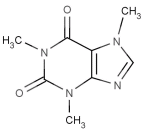Koffie & Cafeïne
Inhoud
- Bronnen van cafeïne - overzicht/drank
- Wat is cafeïne, hoe wordt het gevormd?
Caffeine in coffee
 |
|
| CAS | 58-08-2 |
| Formula | C8H10N4O2 |
| Molecular wt. | 194.19 |
| Melting pt. | 237oC |
| Boiling pt. | 178oC (sublimes) |
| pKa | 10.4 @ 40oC |
| Names | trimethylxanthine, mateine, guaranine, coffeine. |
In its pure state caffeine, or 1,3,7-trimethylxanthine, exists as a white powdered alkaloid with an intensely bitter taste. Caffeine acts as a stimulant for the central nervous system (CNS) having the temporary effect of warding off sleep and restoring alertness in both humans and animals.
It is commonly found in the leaves and beans of over sixty plants worldwide and is believed to have eveolved as a protection mechanism for plants. In arabica coffee, caffeine content averages at 1.2% while Robusta at 2.2%. Its believed that this larger level of caffeine allows for robusta plants to thrive in more hostile environments as caffeine acts as a chemisterilant for insects.
In addition to difference sen between species, researchers have found slight differences across varietals - see Table 2 below.
| Table 2b: Caffeine content by species and variety. | |||
| Species | Variety | Leaf | Bean |
| Arabica | Mundo Novo | 0.98 | 1.11 |
| Typica | 0.88 | 1.05 | |
| Catuai | 0.93 | 1.34 | |
| Laurina | 0.72 | 0.62 | |
| Robusta | Robusta | 0.46 | > 4 |
| Kouillon/Conillon | 0.95 | 2.36 | |
| Laurenti | 1.17 | 2.45 | |
| b: Illy, A. Espresso coffee, 1st ed. | |||
In the beverage, actual concentrations of caffeine depending primarily on the method of brewing and type of coffee used. As seen from Table 2, caffeine levels can vary significantly but its been estimated that 90% of the caffeine is extracted within the first minute of brewing. The variance in caffeine levels is attributed to several factors including extraction time, temperature, grind level and type of coffee used - making true calculations difficult to publish.
| Table 1a: Caffeine content of common beverages | |
| Product | Caffeine Range (mg) |
| Brewed coffee (8oz) | 65-120 |
| Instant coffee (8oz) | 60-85 |
| Decaffeinated coffee, brewed (8oz) | 2-4 |
| Decaffeinated coffee, instant (8oz) | 1-4 |
| Espresso coffee (1oz) | 30-50 |
| Jolt cola (12oz) | 71 |
| Mountain Dew (12oz) | 54 |
| Coca-Cola (12oz) | 46 |
| a: NCA, Aug 1999. www.coffeescience.org | |
Contrary to popular belief, caffeine levels remain virtually unchanged after roasting - its high sublimation temperature and retention within the beans cells make it a very stable compound even at +400oF temperatures.
However, its possible that coffee brewed from darker roasts may contain higher levels of caffeine, since more coffee is required to achieve the desired throw weight.
Recent studies have shown that drinking coffee coffee increases levels of dopamine and glutumate in the brain, thereby having a "pleasurable" effect on the drinker.
Uselful Links: http://www.holymtn.com/tea/caffeine_content.htm
Solinas, M. et al. Caffeine induces dopamine and glutumate release in the shell of the nucleus accumbens. J. of Neuroscience, Aug 1, 2002, 22(15):6321-6324


